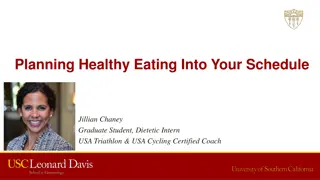Understanding Healthy Eating and Diabetes Workshop: Exploring Food and Nutrition
Delve into the intricacies of food and nutrition at the Healthy Eating and Diabetes Workshop. Discover the main sources of calories in food, the impact of carbohydrates, proteins, and fats, and guidelines on daily intake for a balanced diet, whether you have diabetes or not.
Download Presentation

Please find below an Image/Link to download the presentation.
The content on the website is provided AS IS for your information and personal use only. It may not be sold, licensed, or shared on other websites without obtaining consent from the author. Download presentation by click this link. If you encounter any issues during the download, it is possible that the publisher has removed the file from their server.
E N D
Presentation Transcript
HEALTHY EATING AND DIABETES WORKSHOP UNDERSTANDING FOOD 1ST & 2ND JULY, 2015 BELLE GARDEN COMMUNITY CENTRE BELLE GARDEN, TOBAGO
UNDERSTANDING FOOD Main sources of calories in food To begin with, let us talk about food in general We get nutrients from the foods we eat Foods supply us with energy, or calories To keep our bodies running, we need three main types of food: Carbohydrate Minerals Protein Vitamins Fat Water, Fibre
UNDERSTANDING FOOD Main sources of calories in food
UNDERSTANDING FOOD Calories in food All foods are not equal in calories Fat, for example, has more than twice the calories, gram for gram, as equal amounts of carbohydrates or protein Fat = 9 calories per gram Carbohydrate = 4 calories per gram Protein = 4 calories per gram
UNDERSTANDING FOOD Energy scale for food
UNDERSTANDING FOOD Calorie scale for nutrients
UNDERSTANDING FOOD How much carbohydrate, protein and fat do I need each day? The typical range is: Carbohydrates 45 to 65% of your daily calories Protein 10 to 35% of your daily calories Fat - 25 to 35% of your daily calories This is the case whether you have or do not have diabetes
UNDERSTANDING FOOD How much of each kind of food should we eat?
UNDERSTANDING FOOD Carbohydrates If you have diabetes, you have to know about carbohydrates Why? Among all the foods, carbohydrates have the largest effect on your blood sugar Carbohydrates include starch and sugars
UNDERSTANDING FOOD Carbohydrates During digestion, both forms of carbohydrate break down in your body to single units of sugar, called glucose Carbohydrate is an important part of your diet because the most common sugar unit, glucose, is your body s preferred source of energy or fuel You do not need to avoid carbohydrates because of diabetes - just be able to identify which foods have carbohydrates, and then control the amount you eat
UNDERSTANDING FOOD Carbohydrates are found in: Rice, grains, cereals, and pasta (macaroni, spaghetti) Bread, bakes, ground provision (yam, dasheen, sweet potato), salt biscuits (Crix) Dried beans, split peas and lentils Vegetables, like potatoes, corn, peas Fruit Milk Yogurt Sugars, like table sugar and honey Foods and drinks made with sugar, like regular soft drinks and desserts
UNDERSTANDING FOOD If you have type 1 diabetes, match your carbohydrate intake to your insulin dose. To get the best blood sugar result, your carbohydrate count must be accurate Carbohydrates are counted in grams and even a few grams more or less can make a difference in your blood sugar reading
UNDERSTANDING FOOD Similarly, if you have type 2 diabetes, and are treated with medications that cause insulin to be released from the pancreas or insulin You also must match your carbohydrate intake to your medication dose To get the best blood sugar result, your carbohydrate count must be accurate
UNDERSTANDING FOOD Proteins Protein is an essential part of your diet and your body Too much of a good thing can be bad for you Most meats have fat as well as protein Excess protein from animal sources can mean excess calories and fat which means a greater chance at gaining weight
UNDERSTANDING FOOD Proteins are found in: Beef and pork Poultry Fish and shellfish Eggs Dairy products, like regular cheese Plant-based proteins, like beans and nuts
UNDERSTANDING FOOD Advice about proteins The best advice about protein: get what you need from low-fat protein sources like lean meats, poultry and fish, low fat or nonfat dairy products, and vegetarian protein sources like dried beans If you have kidney problems, you may need to limit how much protein you eat
UNDERSTANDING FOOD Fats Fat is another important part of your diet Remember that fat has twice the calories as equal amounts of carbohydrate or protein Limiting the fat you eat will help you control your weight and prevent heart and blood vessel disease
UNDERSTANDING FOOD Fats are found in: Butter and margarine Oils, like vegetable oil, olive oil and canola oil Salad dressing and mayonnaise Nuts and seeds
UNDERSTANDING FOOD Fats are found in: Meat and protein foods, like beef, cheese, bacon and hot dogs Some fats and oils are heart healthy; others are not Take the time to make low fat choices, and choose heart-healthy fats
HOW TO EAT A BALANCED DIET How to Eat a Balanced Diet It is important to eat a varied and well-balanced diet, especially when you are trying to lose weight to manage your diabetes Cutting calories should not lead to cutting nutrition
HOW TO EAT A BALANCED DIET Exchange Lists for Diabetes: Choose Your Foods In the exchange system, foods with a similar amount of carbohydrate, protein and fat per serving size are grouped together The foods within each list can be exchanged for one another during meal planning and end up with about the same amount of calories and nutrients
HOW TO EAT A BALANCED DIET Exchange Lists for Diabetes: Choose Your Foods Of course, we don t think of food as purely protein, purely fat or purely carbohydrate Different foods are usually a mix of all three To deal with this, we put food into six major exchange food groups based on each food s main content: Staples Foods from animals Fruits Legumes Vegetables Fats and Oils
HOW TO EAT A BALANCED DIET Carbohydrate Protein Fat Food List Calories (grams) (grams) (grams) Carbohydrates Staples 15 0-3 0-1 80 Fruits 15 - - 60 Milk Fat-free, low-fat, 1% 12 8 0-3 100 Reduced-fat, 2% 12 8 5 120 Whole 12 8 8 160 Non-starchy Vegetables 5 2 - 25
HOW TO EAT A BALANCED DIET Carbohydrate Protein Fat Food List Calories (grams) (grams) (grams) Foods from Animals Lean varies 7 0-3 45 Medium-fat - 7 4-7 75 High-fat - 7 8+ 100 Plant-based proteins varies 7 varies varies
HOW TO EAT A BALANCED DIET Carbohydrate Protein Fat Food List Calories (grams) (grams) (grams) Fats & Oils Fats - - 5 45
HOW TO EAT A BALANCED DIET It is important to eat foods from all six lists The exchange system is designed to help you eat a balanced diet with the right amounts of carbohydrate, protein and fat No category of food is off limits
HOW TO EAT A BALANCED DIET When learning to use the exchange system for the first time, follow these helpful steps: Think about your usual foods and food preferences, and locate where each food falls on the exchange list Familiarize yourself with the specific serving sizes listed for each food item that equal one exchange Learn the number of exchanges you need from each food list to plan your daily meals and snacks
HOW TO EAT A BALANCED DIET Sample Exchange Daily Meal Plans Calories Staples Fruit Milk Vegetable Food Fat Portions Portions Portions* Portions from Portions Animals Portions 1200 5 3 2 2 4 3 1300 6 3 2 2 4 3 1400 6 3 2 2 5 4 1500 7 3 2 3 5 4 1600 7 3 3 3 5 4 1700 8 3 3 3 5 5 1800 8 3 3 4 6 5 * Based on non-fat milk (Food from Animals), 50% selections from lean meat list, and 50% selections from medium fat meat list 1900 9 3 3 4 6 5 2000 9 4 3 5 6 6 2100 10 4 3 5 6 6 2200 11 4 3 5 6 7 2300 12 4 3 5 6 7 2400 12 4 3 5 8 8 2500 13 4 3 5 8 8 * Based on non-fat milk (Food from Animals), 50% selections from lean meat list, and 50% selections from medium fat meat list.























